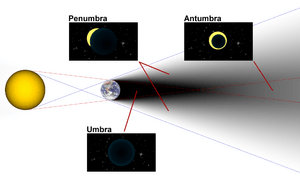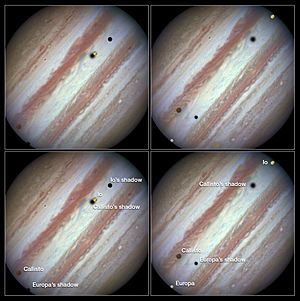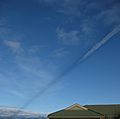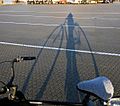Shadow facts for kids
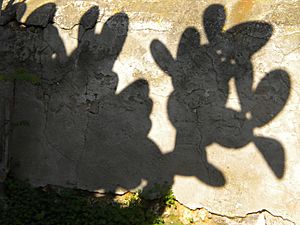
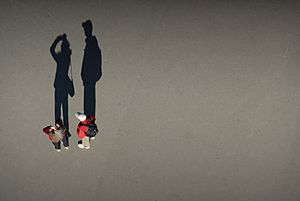
A shadow is a dark area on a bright surface. It is caused by something blocking a source of light. A shadow's outline, called a silhouette, will have the same shape as the object blocking the light.
Depending on the light source, or sources, a wide range of effects can be produced.
A point source of light casts only a simple shadow, called an "umbra". A "penumbra" is the region in which only a portion of the light source may be blocked. If there is more than one light source, there will be several shadows, with the overlapping parts darker, and various combinations of brightness or even colors.
The more diffuse the lighting is, the softer and more indistinct the shadow outlines become, until they disappear. The lighting of an overcast sky produces few visible shadows,
Astronomical shadows are usually sharp. This is because in space the light usually does not go through an atmosphere.
Contents
Point and non-point light sources
A point source of light casts only a simple shadow, called an "umbra". For a non-point or "extended" source of light, the shadow is divided into the umbra, penumbra and antumbra.
The wider the light source, the more blurred the shadow becomes.
If there is more than one light source, there will be several shadows, with the overlapping parts darker, and various combinations of brightnesses or even colors.
The more diffuse the lighting is, the softer and more indistinct the shadow outlines become, until they disappear. The lighting of an overcast sky produces few visible shadows.
Astronomy
The names umbra, penumbra and antumbra are often used for the shadows cast by astronomical objects, though they are sometimes used to describe levels of darkness, such as in sunspots.
The only astronomical objects able to project visible shadows onto Earth are the Sun, the Moon, and in the right conditions, Venus or Jupiter.
Night is caused by the hemisphere of a planet facing its orbital star blocking its sunlight.
A shadow cast by the Earth onto the Moon is a lunar eclipse. A shadow cast by the Moon onto the Earth is a solar eclipse.
Daytime variation
The sun casts shadows which change dramatically through the day. The length of a shadow cast on the ground is depends on the sun's elevation angle relative to the horizon.
Near sunrise and sunset when the sun is very close to the horizon, shadows can be extremely long. If the sun is directly overhead, the shadows are cast directly underneath objects and appear very small.
These things have aided travellers during their travels, especially in barren regions such as the Arabian Desert.
Color
During the daytime, a shadow cast by an opaque object illuminated by sunlight has a bluish tinge. This happens because of Rayleigh scattering, the same property that causes the sky to appear blue. The opaque object is able to block the light of the sun, but not the ambient light of the sky which is blue as the atmosphere molecules scatter blue light more effectively. As a result, the shadow appears bluish.
Dimension
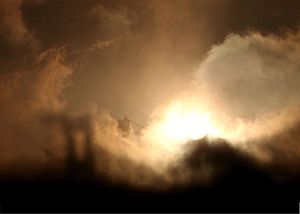
A shadow has three dimensions, but this is usually not visible until it projects onto a reflective surface. A light fog, mist, or dust cloud can reveal this quality.
Theatrical fog and strong beams of light are sometimes used by lighting designers and visual artists who seek to highlight three-dimensional aspects of their work.
Cultural aspects
Shadows often appear in mythical or cultural contexts. Sometimes in a malevolent light, other times not. An unattended shade was thought by some cultures to be similar to that of a ghost. The name for the fear of shadows is "sciophobia" or "sciaphobia".
Chhaya is the Hindu goddess of shadows.
Shadows are often linked with darkness and evil. In common folklore, shadows who come to life are often evil beings, trying to control the people they reflect. The film Upside-Down Magic features a shadow spirit who possesses people.
Ancient Egyptians thought that a shadow, which they called šwt (shut), contains something of the person it represents because it is always present. Through this association, statues of people and deities were sometimes referred to as shadows.
Images for kids
-
Steam phase eruption of Castle Geyser in Yellowstone National Park casts a shadow on its own steam. Crepuscular rays are also visible.
-
Fog shadow of the south tower of the Golden Gate Bridge
-
Sutro Tower casts a 3D fog shadow
-
Clouds, and shadows over the Mediterranean Sea
-
Shadow cast by vapor trail of passing aircraft
See also
 In Spanish: Sombra para niños
In Spanish: Sombra para niños


